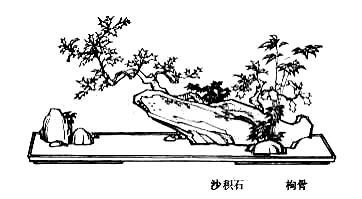Dao De Jing 
 – The Way and Its Power
– The Way and Its Power
The naturalist, individualist and politic doctrine of Lao-tse exhibited in 81 poetic and obscure texts. Tr. Waley (en), Lau (en), Julien (fr) and Wilhelm (de).
| 1 | 2 | 3 | 4 | 5 | 6 | 7 | 8 | 9 | 10 | 11 | 12 | 13 | 14 | 15 | 16 | 17 | 18 | 19 | 20 | 21 | 22 | 23 | 24 | 25 | 26 | 27 | ||
| 28 | 29 | 30 | 31 | 32 | 33 | 34 | 35 | 36 | 37 | 38 | 39 | 40 | 41 | 42 | 43 | 44 | 45 | 46 | 47 | 48 | 49 | 50 | 51 | 52 | 53 | 54 | ||
| 55 | 56 | 57 | 58 | 59 | 60 | 61 | 62 | 63 | 64 | 65 | 66 | 67 | 68 | 69 | 70 | 71 | 72 | 73 | 74 | 75 | 76 | 77 | 78 | 79 | 80 | 81 |
Daodejing I. 14.
Section Dao – Chapter XIV
Because the eye gazes but can catch no glimpse of it,
It is called elusive.
Because the ear listens but cannot hear it,
It is called the rarefied.
Because the hand feels for it but cannot find it,
It is called the infinitesimal.
These three, because they cannot be further scrutinized,
Blend into one,
Its rising brings no light;
Its sinking, no darkness.
Endless the series of things without name
On the way back to where there is nothing.
They are called shapeless shapes;
Forms without form;
Are called vague semblance.
Go towards them, and you can see no front;
Go after them, and you see no rear.
Yet by seizing on the Way that was
You can ride the things that are now.
For to know what once there was, in the Beginning,
This is called the essence of the Way.
Waley 14
不能用眼睛看到它, 叫做“夷”; 不能用耳朵听到它, 叫做“希”; 不能用手摸到它, 叫做“微”。因为我们的眼、耳、身无法感觉它, 因而也无法描述它的形象, 茫茫然, 混然一体。
它既不明亮又不昏暗, 渺茫得难以形容。欲说其无, 万物由它而形成; 欲说其有, 又不见其形。因此只能说它有‘没有形状的形状’, ‘没有物体的形象’, 并把它定义为“惚恍”。
迎着它, 看不到它的头; 跟着它看不到它的尾。然而, 如果能够把握住这恒古之道, 就可以驾御现在的一切。就能了解到原始的情况, 既道的规律。
白话翻译
What cannot be seen is called evanescent;
What cannot be heard is called rarefied;
What cannot be touched is called minute.
These three cannot be fathomed
And so they are confused and looked upon as one.
Its upper part is not dazzling;
Its lower part is not obscure.
Dimly visible, it cannot be named
And returns to that which is without substance.
This is called the shape that has no shape,
The image that is without substance.
This is called indistinct and shadowy.
Go up to it and you will not see its head;
Follow behind it and you will not see its rear.
Hold fast to the way of antiquity
In order to keep in control the realm of today.
The ability to know the beginning of antiquity
Is called the thread running through the way.
Lau 14
Vous le regardez (le Tao) et vous ne le voyez pas : on le dit incolore.
Vous l'écoutez et vous ne l'entendez pas : on le dit aphone.
Vous voulez le toucher et vous ne l'atteignez pas : on le dit incorporel.
Ces trois qualités ne peuvent être scrutées à l'aide de la parole. C'est pourquoi on les confond en une seule.
Sa partie supérieure n'est point éclairée ; sa partie inférieure n'est point obscure.
Il est éternel et ne peut être nommé.
Il rentre dans le non-être.
On l'appelle une forme sans forme, une image sans image.
On l'appelle vague, indéterminé.
Si vous allez au-devant de lui, vous ne voyez point sa face ; si vous le suivez vous ne voyez point son dos.
C'est en observant le Tao des temps anciens qu'on peut gouverner les existences d'aujourd'hui.
Si l'homme peut connaître l'origine des choses anciennes, on dit qu'il tient le fil du Tao.
Julien 14
Man schaut nach ihm und sieht es nicht:
Sein Name ist Keim.
Man horcht nach ihm und hört es nicht:
Sein Name ist Fein.
Man faßt nach ihm, und fühlt es nicht,
Sein Name ist Klein.
Diese drei kann man nicht trennen,
darum bilden sie vermischt Eines.
Sein Oberes ist nicht licht,
sein Unteres ist nicht dunkel.
Ununterbrochen quellend,
kann man es nicht nennen.
Er kehrt wieder zurück zum Nichtwesen.
Das heißt die gestaltlose Gestalt,
das dinglose Bild.
Das heißt das dunkel Chaotische.
Ihm entgegengehend sieht man nicht sein Antlitz,
ihm folgend sieht man nicht seine Rückseite.
Wenn man festhält den SINN des Altertums,
um zu beherrschen das Sein von heute,
so kann man den alten Anfang wissen.
Das heißt des SINNS durchgehender Faden.
Wilhelm 14

The Way and Its Power – Dao De Jing I. 14. – Chinese off/on – Français/English
Alias Daode Jing, Dao De Jing, Tao Te Ching, Tao Teh Ching, le Tao-tö-king, Lao-Tzu Te-Tao Ching, the Laozi, Lao Zi, the Lao Tze, le Lao-tseu, The Book of the Way and its Virtue, the Way and its Power.
The Book of Odes, The Analects, Great Learning, Doctrine of the Mean, Three-characters book, The Book of Changes, The Way and its Power, 300 Tang Poems, The Art of War, Thirty-Six Strategies
Welcome, help, notes, introduction, table.
Index – Contact – Top
